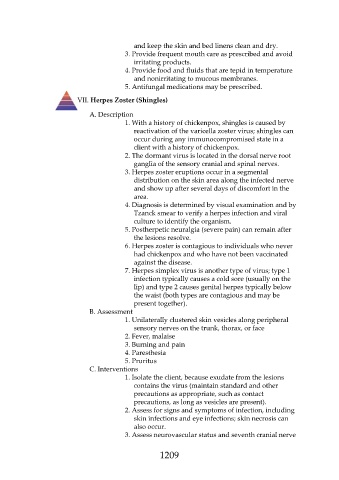Page 1209 - Saunders Comprehensive Review For NCLEX-RN
P. 1209
and keep the skin and bed linens clean and dry.
3. Provide frequent mouth care as prescribed and avoid
irritating products.
4. Provide food and fluids that are tepid in temperature
and nonirritating to mucous membranes.
5. Antifungal medications may be prescribed.
VII. Herpes Zoster (Shingles)
A. Description
1. With a history of chickenpox, shingles is caused by
reactivation of the varicella zoster virus; shingles can
occur during any immunocompromised state in a
client with a history of chickenpox.
2. The dormant virus is located in the dorsal nerve root
ganglia of the sensory cranial and spinal nerves.
3. Herpes zoster eruptions occur in a segmental
distribution on the skin area along the infected nerve
and show up after several days of discomfort in the
area.
4. Diagnosis is determined by visual examination and by
Tzanck smear to verify a herpes infection and viral
culture to identify the organism.
5. Postherpetic neuralgia (severe pain) can remain after
the lesions resolve.
6. Herpes zoster is contagious to individuals who never
had chickenpox and who have not been vaccinated
against the disease.
7. Herpes simplex virus is another type of virus; type 1
infection typically causes a cold sore (usually on the
lip) and type 2 causes genital herpes typically below
the waist (both types are contagious and may be
present together).
B. Assessment
1. Unilaterally clustered skin vesicles along peripheral
sensory nerves on the trunk, thorax, or face
2. Fever, malaise
3. Burning and pain
4. Paresthesia
5. Pruritus
C. Interventions
1. Isolate the client, because exudate from the lesions
contains the virus (maintain standard and other
precautions as appropriate, such as contact
precautions, as long as vesicles are present).
2. Assess for signs and symptoms of infection, including
skin infections and eye infections; skin necrosis can
also occur.
3. Assess neurovascular status and seventh cranial nerve
1209

